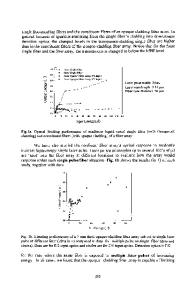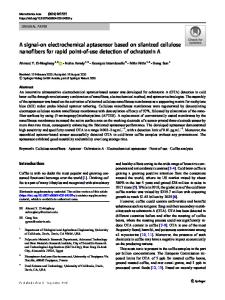Gold nanoparticle-based signal enhancement of an aptasensor for ractopamine using liquid crystal based optical imaging
- PDF / 5,667,327 Bytes
- 9 Pages / 595.276 x 790.866 pts Page_size
- 13 Downloads / 318 Views
ORIGINAL PAPER
Gold nanoparticle-based signal enhancement of an aptasensor for ractopamine using liquid crystal based optical imaging Ying Wang 1,2 & Bing Wang 3 & XingLiang Xiong 2
&
ShiXiong Deng 2
Received: 23 April 2019 / Accepted: 9 September 2019 # Springer-Verlag GmbH Austria, part of Springer Nature 2019
Abstract The authors report on a method for the determination of ractopamine (RAC) via liquid crystal (LC) optical imaging and gold nanoparticle-induced signal enhancement. The gold nanoparticles (AuNPs) were blended with the desired concentrations of RAC, and this is found to strongly improve the performance of the assay. The RAC aptamers were immobilized on the selfassembled film of a glass slide for specific recognition of RAC. This causes a homeotropic re-orientation of the LCs. Notably, the aptamers need not be immobilized on the nanoparticles like in other methods. The addition of RAC causes the formation of an AuNP-RAC-aptamer conjugate on the sensing interface. This disrupts the orientation of LCs and results in a change of the polarized images of the LCs. The method has a detection limit as low as 1 pM of RAC. Keywords Aptamer . Biosensor . Self-assembled film . Glass slide . Recognition . Conjugate . Sensing interface . Orientation . Polarized image . Homeotropic re-orientation
Introduction Ractopamine (RAC) is a synthetic β-adrenergic agonist which is often used as a drug to treat human respiratory diseases [1]. It is also widely used as nutrient agent in animals to enhance the muscle tissues production [2]. However, RAC can be residues in animal tissues and eventually become enriched after entering the human body through the food chain which will generate some detrimental side effects such as headache, nervousness, nausea, Electronic supplementary material The online version of this article (https://doi.org/10.1007/s00604-019-3811-0) contains supplementary material, which is available to authorized users. * XingLiang Xiong [email protected] * ShiXiong Deng [email protected] Ying Wang [email protected] 1
School of Medical Information Engineering, Jining Medical University, Rizhao 276826, Shandong, China
2
Laboratory of Biomedical Engineering, Chongqing Medical University, Chongqing 400016, China
3
Hospital of Traditional Chinese Medicine in Rizhao City, Rizhao 276800, China
muscle tremors, and tachycardia [3, 4]. Although, RAC has been banned for animal feed additives in many countries [5], driven by profits, RAC are still being used in large quantities. It is urgent and important to develop a sensitive and rapid technology of detecting RAC. Up to now, a lot of analytical methods have been applied for the detection of RAC, including gas chromatography–mass spectrometry [6], liquid chromatography-mass spectrometry [7–9], immunoassay [10], capillary electrophoresis [11], and chemiluminescence [12]. Nevertheless, some of the above techniques also exhibit some disadvantages. For example, they are expensive, timeconsuming and have tedious pretreatment procedures. Two approa
Data Loading...











